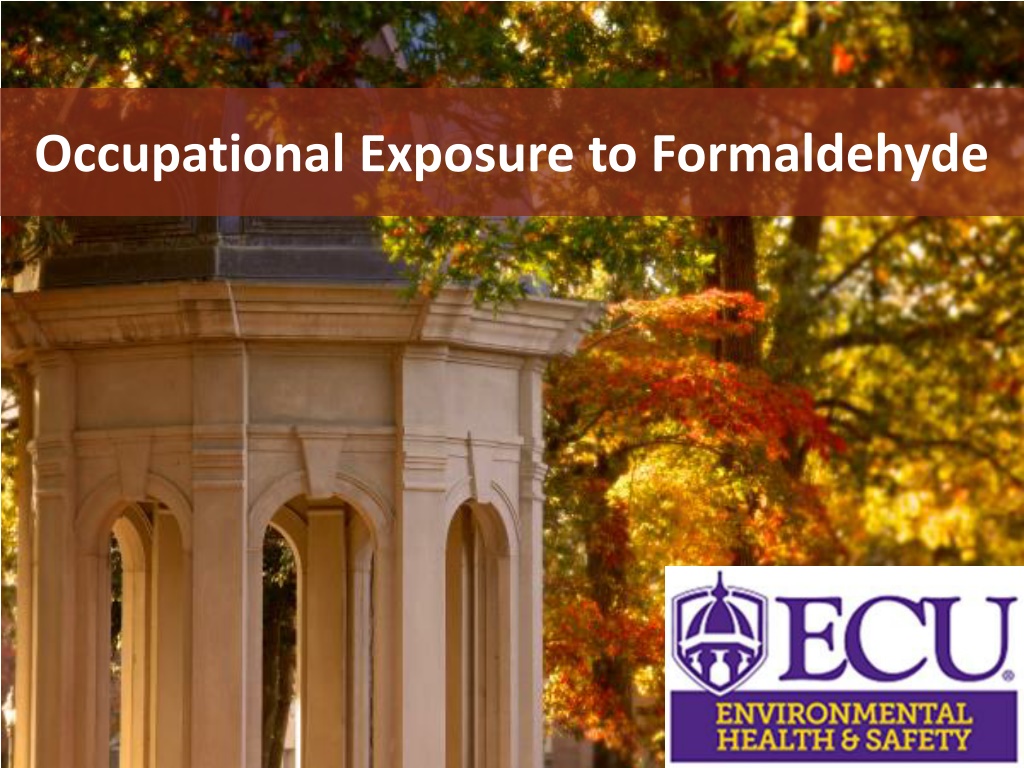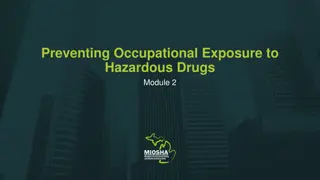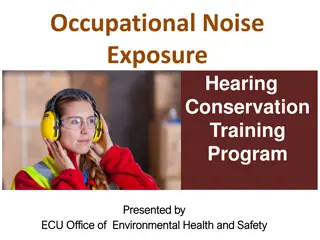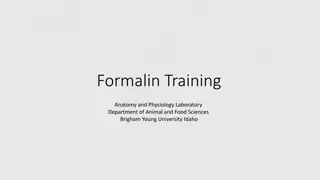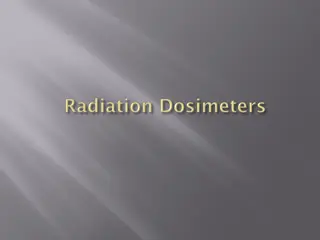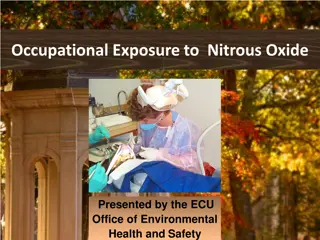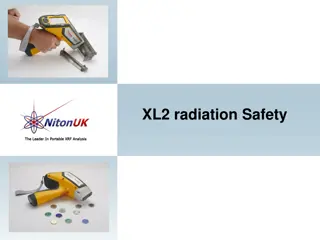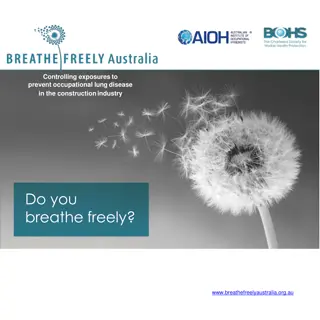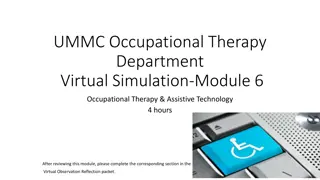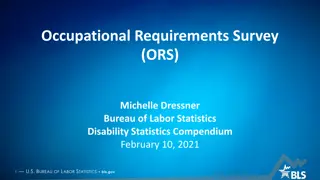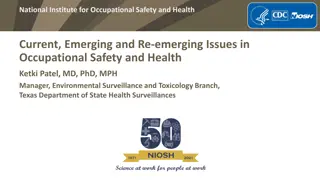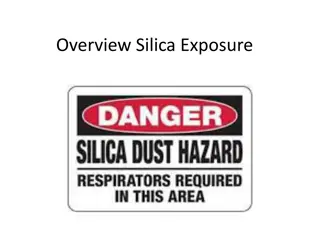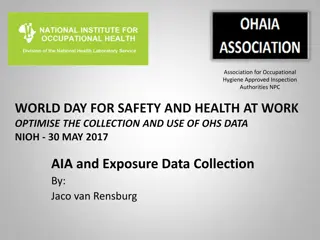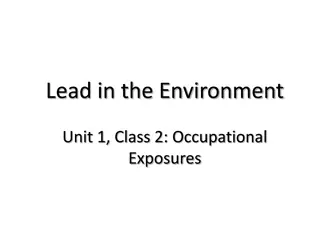Understanding Occupational Exposure to Formaldehyde
Occupational exposure to formaldehyde is common in various industries and settings, including medical laboratories and mortuaries. Formaldehyde is used as a preservative, embalming agent, and in the manufacture of various products. It poses health risks through inhalation and skin exposure, potentially causing irritation, respiratory issues, and skin reactions. Proper safety measures and protective equipment are essential to minimize risks of exposure.
Download Presentation

Please find below an Image/Link to download the presentation.
The content on the website is provided AS IS for your information and personal use only. It may not be sold, licensed, or shared on other websites without obtaining consent from the author. Download presentation by click this link. If you encounter any issues during the download, it is possible that the publisher has removed the file from their server.
E N D
Presentation Transcript
Uses of Formaldehyde Preservative in medical laboratories Embalming agent in mortuaries Manufacture of urea, phenol, and melamine resins and for a variety of special industrialchemicals Adhesives in the manufacture of particle board, fiberboard, and plywood, and for molding, paper treating and coating, textile treating, surface coating, and foams forinsulation Formaldehyde is also used as a treatment for athlete's foot, in cough drops, skin disinfectants, mouthwashes, spermaticcreams, as a disinfectant for vasectomies and rootcanals
Chemical Description Chemical formula: HCHO Colorless gas with a pungent, suffocating odor Synonyms Gaseous formaldehyde are methanal, methyl aldehyde, and methylene oxide Aqueous solution is formalin Highly flammable gas or a combustible liquid Vapors may travel to a source of ignition and flash back Poisonous gases are produced if it catches on fire Containers of formaldehyde may explode in fire
Routes of Exposure In clinical and laboratory settings, exposure to formaldehyde typically occurs through inhalation and skin exposure Inhalation occurs when containers are left uncapped, heated or instruments are not properly vented Formaldehyde should be used in a chemical fume hood Skin exposure occurs when formaldehyde is in contact with skin or eyes. Proper personal protective equipment (see notes) should be worn to minimize the amount of skin contact
Health Effects Formaldehyde is a potential human carcinogen. Airborne concentrations above 0.1 ppm (parts per million parts of air) can cause irritation of the eyes, nose, and throat. Excessive inhalation of vapors can cause acute respiratory distress, chemical pneumonitis, and bronchial asthma. Skin contact may cause various skin reactions including irritation and sensitization. Sensitizer: A chemical that causes a substantial proportion of exposed people or animals to develop an allergic reaction in normal tissue after repeated exposure to the chemical.
Health Effects Acute: Eye and respiratory irritation can result from exposure to the liquid and vapor forms. Severe abdominal pains, nausea, vomiting and possible loss of consciousness could occur if ingested in largeamounts. Chronic: High concentration of vapor inhaled for long periods can cause laryngitis, bronchitis or bronchial pneumonia. Prolonged exposure may cause conjunctivitis. Nasal tumors have been reported in animals. Know the health effects and if you experience any, report them to your supervisor immediately!
How EH&S Monitors Exposure Passive monitors, produced as badges are among the new technologies for detecting formaldehyde. For example, the Assay Technology ChemDisk monitor, shown in the photo, is worn on the lapel to represent the breathing zone. Passive monitor to determine airborne exposure. Monitor is worn for at least 15 minutes or the duration of the work procedure. The monitor is collected and sent to an AIHA accredited laboratory for testing. A report of the results is distributed to the supervisor and the employee.
Exposure Assessment EH&S conducts formaldehyde assessment when it determines that employees are or may be potentially exposed. When does EH&S perform air monitoring? As part of its initial assessment, EH&S may conduct air monitoring to determine baseline with current use and controls. Periodic monitoring are performed when initial results are above the limits or there is a change in the procedure. Air monitoring results are compared to OSHA and ACGIH limits.
Employee Exposure Limits for Formaldehyde OSHA Action Level (AL), 0.5 ppm measured over 8 hours Permissible exposure limit (PEL) 0.75 ppm measured as an 8-hour time weighted average (TWA) Short Term Exposure Limit (STEL) is 2 ppm, maximum exposure allowed during a 15-minute period If exposure exceeds any of these limits, changes must be made to reduce employee exposure. ACGIH TLV Ceiling 0.3 ppm, instantaneous measurement if possible
Labeling and Storage Label must include: Chemical name without abbreviations or symbols Name of the responsible party Hazard class Date opened or expiration date recommended All mixtures and solutions, composed of 0.1 percent or greater formaldehyde and all materials capable of releasing formaldehyde in excess of 0.1 ppm must include a warning that formaldehyde presents a potential cancer hazard Store in a secure, closed container below shoulder level in secondary containment with Class 9 carcinogens
Required Training Initial Training Completion of this presentation and passing grade on quiz Specific training from supervisor on the safe use of formaldehyde in your work environment Annual training for all employees exposed to formaldehyde concentrations of 0.1 ppm or greater ECU employees are generally not exposed to concentrations this high
Safe use in Clinic or Laboratory Create a lab safety plan for formaldehyde use Model plan available SDS available Know the signs and symptoms of exposure Use only in areas designated for carcinogens Wear the appropriate personal protective equipment Front or back closing labcoat Safetygoggles Nitrile or neoprenegloves (Latex gloves do not provide any chemical resistance) No shorts or open toedshoes Wash hands, counters and equipment after use
Spills and Leaks Wear suitable personal protective equipment. Do not touch the spilled material; stop the leak if it is possible to do so without risk. Remove sources of ignition. Isolate the area so others do not inadvertently become exposed or transport the spilled material. If you cannot safely handle the spill, contact EH&S immediately at 328-6166.
To receive credit for this training please complete the linked QUIZ Questions 211 South Jarvis Street, Suite 102, Greenville NC 27858 Online: www.ecu.edu/oehs Email: safety@ecu.edu Phone: (252) 328-6166
